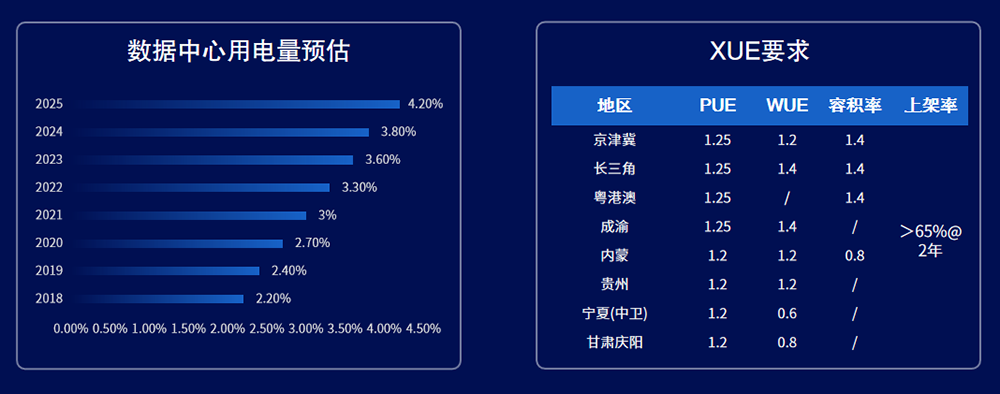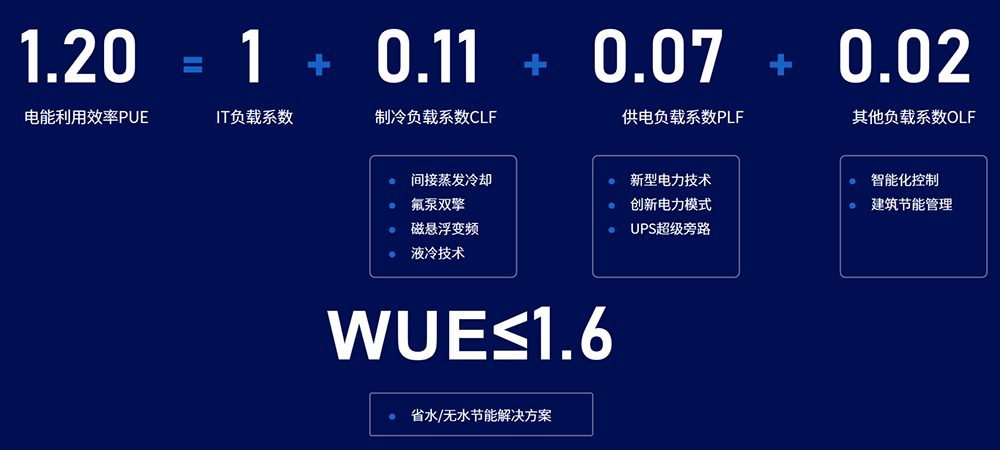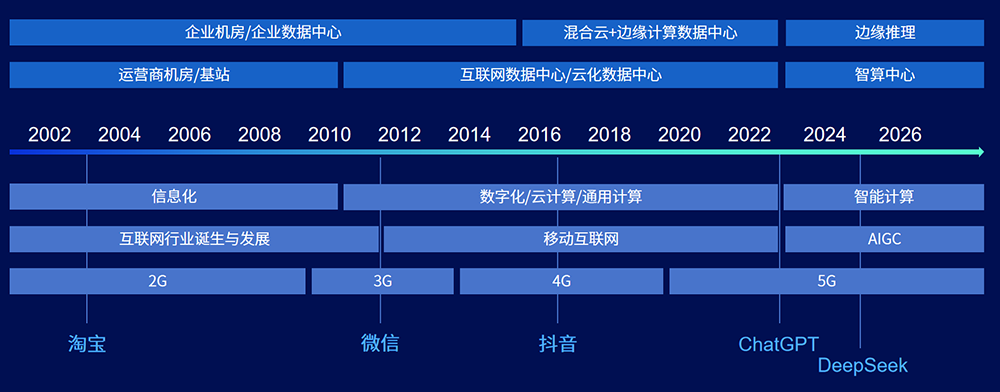1. The development trend of data center technology
The development history of China's data center industry
The development of China's data center industry can be clearly divided into three key stages: informatization, digitalization, cloud computing, general computing, and intelligent computing, each of which is closely linked to network technology iteration and industrial demand upgrades:
- 2002-2010 (informatization stage): With the rise of 2G/3G networks, the Internet industry emerged and developed rapidly. During this period, the vigorous growth of e-commerce platforms represented by Alibaba Taobao greatly promoted the demand for operators' computer rooms, base stations, enterprise computer rooms and enterprise data centers, and the construction of data centers entered a period of initial expansion.
- 2010 - 2022 (digitalization / cloud computing / general computing stage): 3G/4G/5G network communication technology has achieved leapfrog development, and mobile Internet has ushered in explosive growth. The rise of mobile social software such as WeChat and short video platforms such as Douyin has led to a surge in demand for Internet data centers and cloud-based data centers, while the demand for hybrid cloud and edge computing data centers, enterprise computer rooms and enterprise data centers has also continued to grow, and data centers have evolved in the direction of diversification and cloudification.
- 2022 - 2026 (intelligent computing stage): The wave of AIGC (generative artificial intelligence) in the 5G era has swept in, large models such as ChatGPT and DeepSeek have emerged, and edge inference technology has been comprehensively developed. At this stage, the computing power demand of data centers has increased exponentially, and intelligent computing has become the core driving force for the development of the industry.

Energy conservation and low carbon, the sustainable development path of data centers
Under the guidance of the "dual carbon" goal, data centers are transforming towards energy-saving, low-carbon and sustainable directions, which are embodied in three levels: energy production, consumption and management:
(1) Low-carbon energy production
Data centers have been gradually upgraded from simple energy systems to integrated energy systems, actively embracing green energy and energy storage technologies:
- Green power applications: Large-scale introduction of renewable energy such as photovoltaic and wind power to reduce dependence on traditional fossil energy and reduce carbon emissions from energy sources.
- Energy storage technology: Peak shaving and valley filling are achieved through energy storage systems, improving energy utilization efficiency and enhancing the energy resilience of data centers.
(2) Energy consumption saving
The industry's requirements for data center energy efficiency are becoming increasingly stringent, and the evaluation indicators have expanded from the initial PUE (Electrical Energy Utilization Efficiency) to WUE (Water Utilization Efficiency) and CUE (Carbon Utilization Efficiency), and the "four sections" (water saving, power saving, land saving, and material saving) have been achieved through various measures:
- Minimalist architecture: Simplify the data center infrastructure architecture and reduce unnecessary energy losses.
- Efficient components: Adopt energy-efficient servers, refrigeration equipment and other core components to improve energy conversion efficiency.
- Natural cooling: Make full use of natural cooling sources (such as cold air, cooling water) to reduce the energy consumption of mechanical cooling.
- Comprehensive saving: fully implement the concepts of water, electricity, land and material conservation in design and operation to achieve efficient use of resources.
(3) Intelligent energy management
Data center operation and maintenance are accelerating the transformation to digital, intelligent, and unmanned to improve energy management:
- AI-Powered Technology: Utilize AI technology to monitor, analyze, and predict energy consumption in real-time, optimizing energy distribution.
- Unmanned O&M: Introduce automated O&M equipment and systems to reduce manual intervention and improve O&M efficiency and accuracy.
- Energy Efficiency Tuning: Dynamically adjust the operating status of equipment through intelligent algorithms to achieve continuous optimization of overall energy efficiency.

High-density heat dissipation, low-carbon and energy-saving, liquid cooling is the best solution
With the explosive growth of computing power demand, server power density has continued to rise, from 100-130W in 2018 to 1200W today.
- Power consumption difference: The CPU's TDP (Thermal Design Power Consumption) has reached 350W, and the GPU is as high as 750W; general-purpose servers have a power of about 700W, while AI training servers like GB200 reach 9800W; The general computing power of a single cabinet is 14kW, and the power of a single cabinet AI server is 40-120kW.
- Cooling bottlenecks and breakthroughs: Traditional air-cooled cooling technologies are approaching their limits, making it difficult to meet the heat dissipation needs of high-power density devices. Liquid cooling technology is the optimal solution for low-carbon energy conservation due to its efficient heat dissipation capabilities. In terms of PUE (Electrical Energy Utilization Efficiency), the PUE of air-cooled is between 1.25-1.4; In liquid cooling technology, the PUE of single-phase cold plate liquid cooling is 1.2-1.25, the two-phase cold plate liquid cooling is 1.15-1.2, the single-phase immersion liquid cooling is 1-1.15, and the two-phase immersion liquid cooling is as low as 0.5-1.15, which is significantly better than air cooling.

New industry landscape - from data centers to intelligent computing centers
With the in-depth development of artificial intelligence, the form of data centers has been continuously upgraded, gradually forming a diversified intelligent computing center pattern:
- Supercomputing Centers: About 10 new ones have been added, mainly distributed in comprehensive national science centers such as Zhengzhou, Chengdu, Hefei, and Lanzhou, providing strong computing power support for major scientific research.
- Intelligent computing centers: More than 10 new ones are expected to reach dozens, concentrated in Wuhan, Nanjing, Xi'an, Shanghai, Shenzhen, Beijing and other national new generation artificial intelligence innovation and development pilot zones and national artificial intelligence innovation and application pilot zones, focusing on artificial intelligence-related computing needs.
- Integrated big data center: 8 major nodes are planned, and more than 10 data center clusters are distributed in Beijing-Tianjin-Hebei, Guangdong-Hong Kong-Macao, Yangtze River Delta, Chengdu-Chongqing, Inner Mongolia, Guizhou, Ningxia, Gansu and other national integrated big data centers and national computing power hub nodes, aiming to achieve overall scheduling and efficient utilization of national computing power.
- Urban Cloud Brain / Edge Data Center: Hundreds are expected to be built, and the Ministry of Housing and Urban-Rural Development has piloted 290 smart city city brains, which are close to the user side and provide low-latency computing power support for smart cities, edge computing and other scenarios.
Challenges of intelligent computing centers: elasticity, TTM, high reliability, and high availability
The intelligent computing center faces many challenges in the development process, and needs to continue to innovate in technology and operation mode:
- Business diversity: It covers a variety of business types such as general computing, intelligent computing training, and intelligent computing reasoning, and the demand for computing power varies greatly.
- Server Type Diversity: Involving multiple server types such as CPUs, domestic Xinchuang cards, NV cards, and L1 and L2 coupling, adding complexity to hardware management.
- Complexity of physical scenarios: The impact of physical factors such as wind-liquid ratio, climatic conditions, and the number of floors in the computer room on infrastructure needs to be considered.
- Infrastructure requirements: It needs to meet requirements such as green efficiency, high reliability/high availability, flexible deployment, and short TTM (Time to Market) to quickly respond to business needs and reduce operating costs.

The path to achieve key evaluation indicators of data centers
The calculation formula is: 1.20=1+0.11+0.07+0.02, that is, PUE=IT load factor + cooling load coefficient CLF + power supply load coefficient PLF + other load coefficient OLF. The optimization path for each coefficient is as follows:
- Refrigeration load coefficient CLF: Adopt high-efficiency refrigeration solutions such as indirect evaporative cooling, fluorine pump dual engine, magnetic levitation frequency conversion, and liquid cooling technology to reduce the energy consumption of the refrigeration system.
- Power supply load factor PLF: Introduce new power technologies, innovative power modes, UPS super bypass, etc., to improve the efficiency and reliability of the power supply system.
- Other load factor OLF: Reduce energy loss in other links through intelligent control and building energy-saving management.
- WUE (Water Use Efficiency): Uses water-saving/water-free energy-saving solutions to keep WUE within the ≤1.6 range.

Distributed refrigeration architecture - the life cycle of planning, construction, operation and maintenance is controllable
Compared with traditional centralized refrigeration architectures, distributed refrigeration architectures have significant advantages in full life cycle management:
- Centralized refrigeration: There are problems such as high risk of single point failure and wide impact, complex pipeline design leading to long overall construction period (TTM>240 days), and high professional requirements for operation and maintenance personnel due to decentralized supply of the same system.
- Distributed structure:
- Planning phase: Distributed architecture makes the refrigeration system more reliable and reduces the impact of a single point of failure.
- Construction stage: Adopt factory prefabrication method to significantly shorten the TTM cycle (TTM<90 days) and speed up the commissioning of the data center.
- Operation stage: Built-in system control logic can realize intelligent optimization operation and improve operational efficiency.
- Maintenance stage: The productization of the system reduces the requirements for maintenance personnel in multiple fields of expertise and facilitates maintenance management.

The development direction of refrigeration technology solutions
With the increasing requirements of data centers for energy conservation and heat dissipation, the refrigeration technology solutions are constantly upgraded, and the PUE and characteristics of different solutions are as follows:
- Generally, air-cooled :P UE=2.0, the technology is mature but the energy efficiency is low.
- Full inverter chilled water :P UE=1.5, combined with general air-cooled and air-cooled fluorine pump technology, the energy efficiency has been improved.
- Natural cooling + chilled water :P UE=1.4, which adopts the combination of full frequency conversion / chilled water and natural cooling / chilled water, which has the characteristics of reliability and stability, but the amount of maintenance is relatively large.
- Indirect evaporative cooling, integral all-weather energy saving, magnetic levitation multi-connection :P UE≤1.2 belongs to a new temperature control product series, with the advantages of high energy efficiency, low water consumption, and rapid deployment.
- High-density wind wall, cold plate liquid cooling, wind-liquid fusion :P UE≤1.1 is a high-density solution with more efficient, high-density, reliable, quiet, clean and other characteristics, which can meet the heat dissipation needs of high-power density equipment.


